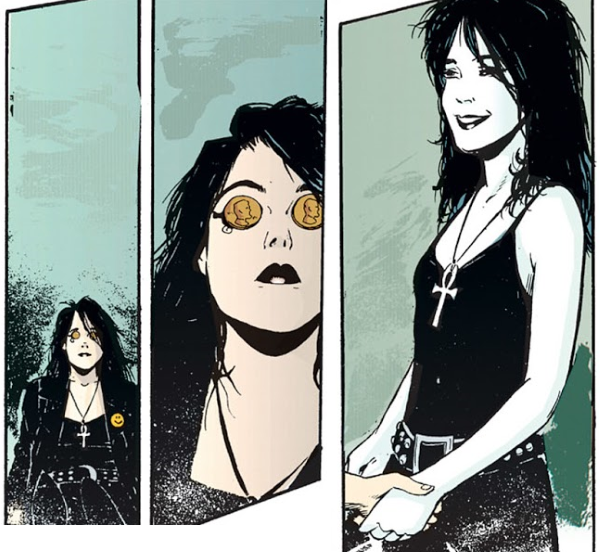Confessor
CCF Mod Squad
Not Bucky O'Hare!
Posts: 10,197 
|
Post by Confessor on Jul 27, 2022 13:27:46 GMT -5
Death: The Time of Your Life #1–3 Original publication dates: April 1996 – June 1996 Script: Neil Gaiman Artwork: Chris Bachalo (pencils)/Mark Buckingham (pencils & inks)/Mark Pennington (inks) 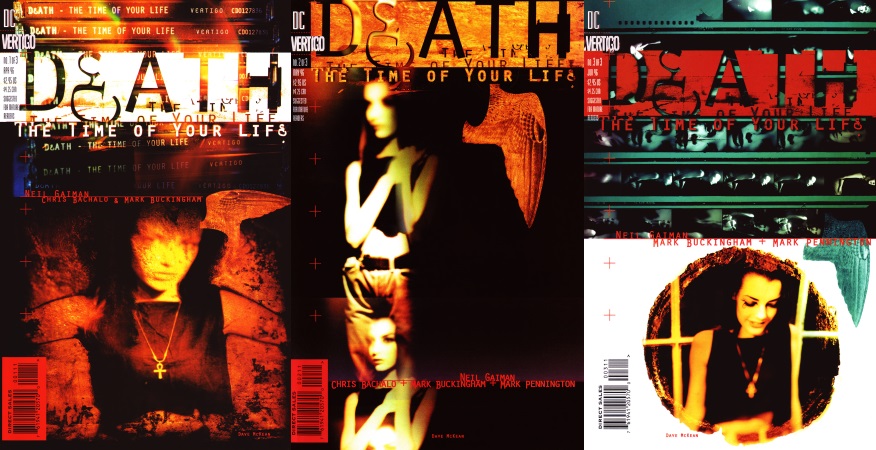 Publisher's synopsis Publisher's synopsis: A rising star of the music world wrestles with revealing her true sexual orientation just as her lover is lured into the realm of Death that Death herself should make an appearance. A practical, honest, and intelligent story that illuminates "the miracle of death."So, here we go with another review for a Sandman spin-off series. I'm planning to do a couple more reviews of spin-offs before the Netflix live action Sandman adaptation begins on 5th August. Published in 1996, Death: The Time of Your Life was the second three-issue mini-series that Neil Gaiman wrote focusing on the quirky, chipper teenage girl in a goth dress who is the personification of Death. Like Death: The High Cost of Living, this mini-series focuses in on a particular character – in this case Floxglove, who we have previously met a couple of times before in the series – who has to come to terms with an existential problem, while Death herself plays an important, but ultimately supporting role in proceedings. In fact, she doesn't really feature all that much at all. Foxglove and Hazel had both previously appeared in the A Game of You storyline, and then Foxglove also made a brief appearance in the first Death mini-series, in which we learned that she had begun to gain a modicum of success in her music career. Here though, we find that Foxglove is now a bona fide up-and-coming pop superstar – the "queen of acoustic rock and roll", no less! Her career keeps her on the busy, globe-trotting treadmill of a touring musician, which furnishes her with all the trappings of stardom, but has taken its toll on her relationship with her stay-at-home partner Hazel. The pair have an infant son named Alvie, who we learn has died in the opening pages of The Time of Your Life. However, Foxglove was away on tour at the time and is therefore unaware of what happened since Hazel made a deal with Death to bring Alvie back to life for a little while longer. The bargain that Hazel struck was that, when Foxglove returned home, the two women would again visit Death's realm, but this time one of them would stay behind in place of the child. So, essentially Hazel has struck a deal to exchange another life – her own or Foxglove's – for Alvie's. Ultimately, I've gotta say that this mini-series left me with a distinct feeling of, "meh". One of the biggest problems I had with it was that, at the tale's climax, it isn't Foxglove or Hazel who have to sacrifice themselves to save Alvie – it's an assistant and bodyguard of Foxglove's named Boris. This feels like a bit of a cheat on Gaiman's part; Foxglove and Hazel are the main focus of this story until the very end, when a two-dimensional supporting character ends up doing the pair's dirty work for them for no adequately explained reason. I mean, why would Boris decide to end his life to save a child he had never met? Did he have an especially bad life? Was he really unhappy? Frankly, he was so underdeveloped as a character that his making the ultimate sacrifice was a real head-scratcher for me. Why on Earth would an apparently healthy assistant/bodyguard in their mid-30s give up their life in this way? It seemed pretty unbelievable and it would've been much more satisfying to have had either Hazel or Foxglove resolve the problem somehow. Yeah, as I say, this just seemed like a really lame ending and a bit of a cop out on Gaiman's part. On the plus side, Gaiman still has the ability to write some superb, thought-provoking dialogue on occasion – especially where Death is concerned. Take this exchange between Hazel and Death for example: powerful stuff... 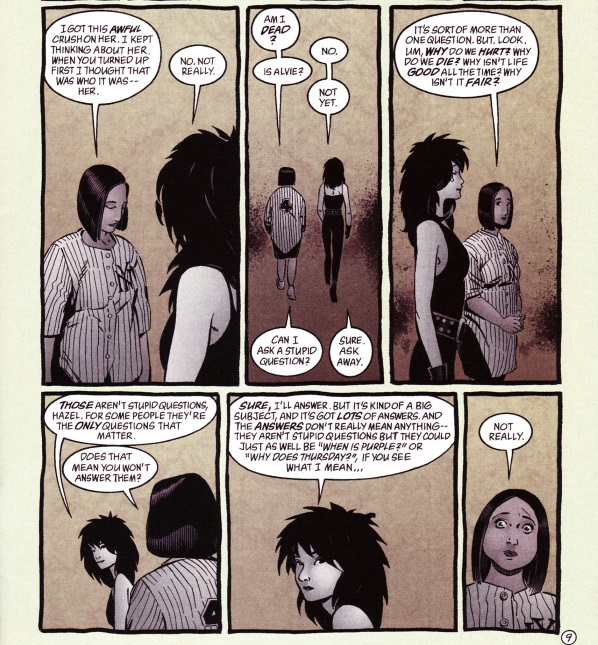  Chris Bachalo's artwork in the early parts of this story is rather nice, with clean lines and some inventive use of the panels. His art has a "rough-around-the-edges" urban aesthetic, which inker Mark Buckingham smooths nicely. Bachalo's art serves the story well and moves things forward in a pleasing manner, panel to panel. Buckingham takes over on pencils half way through issue #2, but since he was inking Bachalo's stuff anyway, the transition isn't especially noticeable. I also want to make note of Bachalo's use of a chequerboard pattern on the page borders, while Floxglove's story is being told. This striking pattern alludes to the black-and-white chequered face paint that we saw Foxglove applying way back in the A Game of You arc... 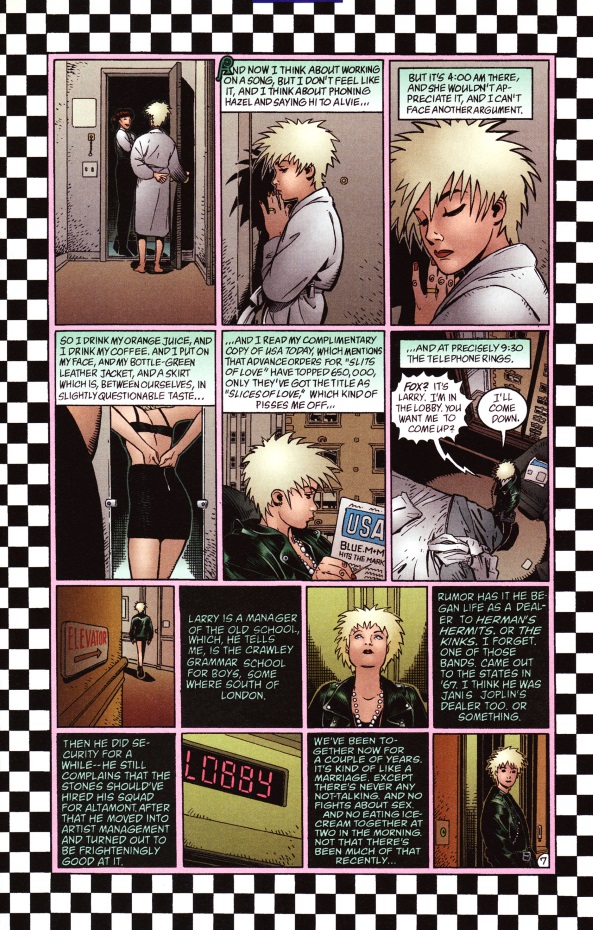 Something else I had a problem with in this mini-series was that, although seeing Foxglove wrestle with typical (and slightly clichéd) price-of-fame concerns – while being forced to remain "in the closest" about her sexuality by her manager – was interesting enough as I read it, this mini-series just seemed rather inconsequential. Like, why was this a story worth telling? The scope of this mini-series was colossal, and yet, the whole thing felt rather lightweight and lacking in gravitas. I could've easily skipped this and I really wouldn't have missed anything.
|
|
|
|
Post by Roquefort Raider on Jul 27, 2022 14:28:48 GMT -5
(...) Foxglove and Hazel had both previously appeared in the A Game of You storyline, and then Foxglove also made a brief appearance in the first Death mini-series, in which we learned that she had begun to gain a modicum of success in her music career. If I'm not mistaken, it was also revealed along the way that Foxglove was the girl on the phone with Judy in the infamous Diner scene with John Dee. Gaiman really ran a tight ship when it came to continuity! I reaaaaally didn't like that idea. It smacked of ad hoc plot convenience, something Gaiman isn't known for usually. I mean, such things do not happen in real life, ever, and the way Death had been depicted up to that point suggested that she pretty much obeyed the rules we do observe : you get a lifetime, and then you die, period Same here. Nice art, but a plot that left me completely unmoved emotionally (which is pretty bad considering we're talking about the loss of a child and the ultimate sacrifice of a mother).
For my part I find that kind of reasoning to be annoyingly facile. The whole "can't have good without evil, can't have light without darkness" bit isn't only very old, but also utterly unconvincing.
"Why does my husband beat me?" "So you'll appreciate the times he doesn't". How would that make any kind of sense???
I'm sure we can appreciate health without ever having been sick, friendship without having enemies, and marital devotion without having been cheated on. Yes, contrast emphasizes the good over the bad, but it doesn't make the good better; it just makes it more obvious.
I preferred death's answer about fairness when she explained how things went to the dead baby, early in the Sandman series: "you get what everybody gets: a lifetime". That's just the way things are, and fairness isn't counted among the universe's attributes; it's just a concept we came up with.
Going back to your earlier question on Sandman: Ouverture, that's pretty much what I thought of that OGN. The fate of the universe everywhere all at once notwithstanding, it, too, felt like a tale that didn't need to be told (but looked pretty and had some neat dialog). |
|
|
|
Post by Slam_Bradley on Jul 27, 2022 14:54:56 GMT -5
(...) Foxglove and Hazel had both previously appeared in the A Game of You storyline, and then Foxglove also made a brief appearance in the first Death mini-series, in which we learned that she had begun to gain a modicum of success in her music career. If I'm not mistaken, it was also revealed along the way that Foxglove was the girl on the phone with Judy in the infamous Diner scene with John Dee. Gaiman really ran a tight ship when it came to continuity! Yes, Fox was on the phone with Judy as they had been in a relationship. I pretty much agree that this was weak compared to the first mini and Sandman in general. I've not re-visited it very often as a result. |
|
Confessor
CCF Mod Squad
Not Bucky O'Hare!
Posts: 10,197 
|
Post by Confessor on Jul 27, 2022 18:08:31 GMT -5
For my part I find that kind of reasoning to be annoyingly facile. The whole "can't have good without evil, can't have light without darkness" bit isn't only very old, but also utterly unconvincing. I'm sure we can appreciate health without ever having been sick, friendship without having enemies, and marital devotion without having been cheated on. Yes, contrast emphasizes the good over the bad, but it doesn't make the good better; it just makes it more obvious. I agree that the distinction between this type of contrast emphasising the difference between life's extremes and it actually making the good "better" is an important one to make. However, I really don't see this kind of philosophy as facile at all. The truth is that simply having the contrast isn't enough; humans can be taught what "good" is, but in order to truly understand "good" they need to experience "bad". That's not just some washy-washy pop philosophy: it's a core component of human existence. Our perception of reality is based on our analysing contrasting emotional states: that is how we navigate through our own particular mental landscapes. There's even a term in psychology for when humans fail to contrast poor experiences against good -- hedonic adaptation. Essentially, without life getting crappy from time to time you begin to take the good times for granted. |
|
|
|
Post by Roquefort Raider on Jul 28, 2022 6:00:07 GMT -5
For my part I find that kind of reasoning to be annoyingly facile. The whole "can't have good without evil, can't have light without darkness" bit isn't only very old, but also utterly unconvincing. I'm sure we can appreciate health without ever having been sick, friendship without having enemies, and marital devotion without having been cheated on. Yes, contrast emphasizes the good over the bad, but it doesn't make the good better; it just makes it more obvious. I agree that the distinction between this type of contrast emphasising the difference between life's extremes and it actually making the good "better" is an important one to make. However, I really don't see this kind of philosophy as facile at all. The truth is that simply having the contrast isn't enough; humans can be taught what "good" is, but in order to truly understand "good" they need to experience "bad". That's not just some washy-washy pop philosophy: it's a core component of human existence. Our perception of reality is based on our analysing contrasting emotional states: that is how we navigate through our own particular mental landscapes. There's even a term in psychology for when humans fail to contrast poor experiences against good -- hedonic adaptation. Essentially, without life getting crappy from to time you begin to take the good times for granted. I agree, but taking things for granted is a personal attitude; it has no bearing on the kind of grand universal truths that Death would deal with. "Why are things unfair" is, to me, a question akin to "why does the second law of thermodynamics rule the universe" : it doesn't have a reason, psychological or otherwise; it's just the way things are. We do appreciate good things more (for a while) when we have been deprived of them, but we can also appreciate them without prior deprivation. I'd argue that post-trauma appreciation is more about a sense of relief (which is genuine, powerful, but transient) than about the inability to appreciate something without the presence of its opposite. The universe doesn't care about us, nor about whether we find things fair or not. In fact, even were it conscious, it could claim that it is actually quite fair since we all die in the end and everything is headed toward the heat death of the universe. On such scales, whether a crook lives long and leads a happy life or whether a good person struggles and suffers makes little difference; only the individual, granted a limited life and judging everything through their own limited experience, will believe that things are fair or unfair. Hazel and Deaths discussion here is basically the "why do kids get cancer" debate. I can't imagine any philosophical reason for it, and especially not "so we can appreciate it when kids don't get cancer." As the dude in Hell said in the Sandman series, "that makes it worse... that makes it so much worse". Come on, Death, tell it like it is! "Life is unfair because that's how things are, Hazel, and you couldn't exist in a universe that would be otherwise". |
|
Confessor
CCF Mod Squad
Not Bucky O'Hare!
Posts: 10,197 
|
Post by Confessor on Jul 28, 2022 7:24:01 GMT -5
I agree that the distinction between this type of contrast emphasising the difference between life's extremes and it actually making the good "better" is an important one to make. However, I really don't see this kind of philosophy as facile at all. The truth is that simply having the contrast isn't enough; humans can be taught what "good" is, but in order to truly understand "good" they need to experience "bad". That's not just some washy-washy pop philosophy: it's a core component of human existence. Our perception of reality is based on our analysing contrasting emotional states: that is how we navigate through our own particular mental landscapes. There's even a term in psychology for when humans fail to contrast poor experiences against good -- hedonic adaptation. Essentially, without life getting crappy from to time you begin to take the good times for granted. I agree, but taking things for granted is a personal attitude; it has no bearing on the kind of grand universal truths that Death would deal with. "Why are things unfair" is, to me, a question akin to "why does the second law of thermodynamics rule the universe" : it doesn't have a reason, psychological or otherwise; it's just the way things are. We do appreciate good things more (for a while) when we have been deprived of them, but we can also appreciate them without prior deprivation. I'd argue that post-trauma appreciation is more about a sense of relief (which is genuine, powerful, but transient) than about the inability to appreciate something without the presence of its opposite. The universe doesn't care about us, nor about whether we find things fair or not. In fact, even were it conscious, it could claim that it is actually quite fair since we all die in the end and everything is headed toward the heat death of the universe. On such scales, whether a crook lives long and leads a happy life or whether a good person struggles and suffers makes little difference; only the individual, granted a limited life and judging everything through their own limited experience, will believe that things are fair or unfair. Hazel and Deaths discussion here is basically the "why do kids get cancer" debate. I can't imagine any philosophical reason for it, and especially not "so we can appreciate it when kids don't get cancer." As the dude in Hell said in the Sandman series, "that makes it worse... that makes it so much worse". Come on, Death, tell it like it is! "Life is unfair because that's how things are, Hazel, and you couldn't exist in a universe that would be otherwise". Great reply, RR. Really enjoyed reading it. |
|
|
|
Post by tonebone on Jul 28, 2022 15:36:38 GMT -5
As an aside and for the completists, The Sandman was also collected outwith the USA. Here's my French copy of book three which (a very American English) info box on an intro page tells us collects "Issue #9 through #12". (c)1997. It's the first part of A Doll's House (La Maison de Poupée). The book is regular US floppy sized but printed on VERY shiny paper which makes the colours even brighter and harsher than my softcover. There's nothing else in the book other than the pages of the comics. No Intros, no essays, no nuttin' - just the strip. Oddly (and this is very ugly) where Part Two of The Dolls House starts (just before ' Moving In') There is a blank white page where, in the US version I have, there is a page of McKean art. And you would have thought that someone somewhere would have noticed that 'Contes dans les Sables' has the same arrangement of Ss in the middle as 'Tales of the Sand' and done a better job of retaining some semblance of the original calligraphy on the opening page.   I have the French hardcover of Seasons of Mists, which is my favorite collection. |
|
|
|
Post by spoon on Dec 24, 2023 23:33:20 GMT -5
The Sandman: Volume 1 – Preludes & NocturnesOriginal publication: The Sandman #1–8 (January 1989 – August 1989) Script: Neil Gaiman Artwork: Sam Kieth (pencils)/Mike Dringenberg (pencils & inks)/Malcolm Jones III (inks) 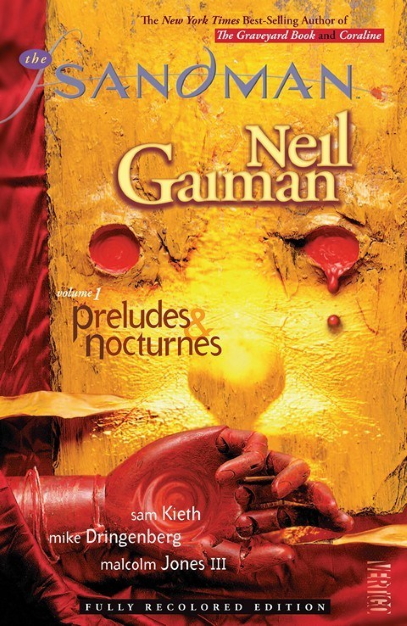 I also didn't think much of the overly gory chapter involving Doctor Destiny sitting in a diner. I felt that it unfortunately read like a lot of other "for mature readers" comics from the 1990s, with some rather immature "oh-so-gritty" violence and mutilations randomly thrown in for no good reason. This chapter in particular made "Preludes & Nocturnes" seem more like what a 15-year-old boy would think of as mature writing, as opposed to what mature writing really is – something that a lot of 1990s "for mature readers" books suffer from, IMHO. This was a part that bugged me and I referred to in my Read Lately post. I like some horror and I dislike some. Sometimes it's hard to describe where the dividing line is, but I tend not to like works that feel like torture porn. Interestingly, it often feels the most distasteful if the victim is somewhere in the middle morally. If the victim is basically a good person, like the woman who Doctor Destiny forced to drive him to the diner at gunpoint, then the focus is on the evil of the villain. If the victims are really seems grievously and irredeemably bad, then it doesn't feel so sickening. The situation where it feels really prurient is like this seen in the diner, where it seems to have the tone of a comeuppance, but for peccadillos. It's like the writer wants a person to take pleasure in how deserved the suffering is, when the suffering is way, way, way out of proportion to the victims' supposed misdeeds. |
|
Confessor
CCF Mod Squad
Not Bucky O'Hare!
Posts: 10,197 
|
Post by Confessor on Dec 25, 2023 2:34:09 GMT -5
The Sandman: Volume 1 – Preludes & NocturnesOriginal publication: The Sandman #1–8 (January 1989 – August 1989) Script: Neil Gaiman Artwork: Sam Kieth (pencils)/Mike Dringenberg (pencils & inks)/Malcolm Jones III (inks)  I also didn't think much of the overly gory chapter involving Doctor Destiny sitting in a diner. I felt that it unfortunately read like a lot of other "for mature readers" comics from the 1990s, with some rather immature "oh-so-gritty" violence and mutilations randomly thrown in for no good reason. This chapter in particular made "Preludes & Nocturnes" seem more like what a 15-year-old boy would think of as mature writing, as opposed to what mature writing really is – something that a lot of 1990s "for mature readers" books suffer from, IMHO. This was a part that bugged me and I referred to in my Read Lately post. I like some horror and I dislike some. Sometimes it's hard to describe where the dividing line is, but I tend not to like works that feel like torture porn. Interestingly, it often feels the most distasteful if the victim is somewhere in the middle morally. If the victim is basically a good person, like the woman who Doctor Destiny forced to drive him to the diner at gunpoint, then the focus is on the evil of the villain. If the victims are really seems grievously and irredeemably bad, then it doesn't feel so sickening. The situation where it feels really prurient is like this seen in the diner, where it seems to have the tone of a comeuppance, but for peccadillos. It's like the writer wants a person to take pleasure in how deserved the suffering is, when the suffering is way, way, way out of proportion to the victims' supposed misdeeds. Yeah, I agree. I know this particular issue set in the diner has its fans in the forum, but for me it might well be my least favourite single issue of The Sandman. It just felt unnecessarily over-the-top brutal and gory, which lent it a rather pathetic "ooh, look...this is sooo edgy" vibe. It all felt rather puerile and childish to me, in all honesty. |
|
|
|
Post by commond on Dec 25, 2023 16:50:23 GMT -5
Eh, 15 year-olds weren't writing anything as good as the Vertigo books. And believe me, I tried.
I think it's important to read the early parts of any run, be it early Sandman, Conan-parody Cerebus, or the early volumes of Berserk which Cartoonist Kayfabe panned to get a reaction out of Berserk fans. It's part of the growth and development stage of the writer/artist, but also part of the story. In many respects, it helps you appreciate what the book became if you know where it started from.
|
|
Confessor
CCF Mod Squad
Not Bucky O'Hare!
Posts: 10,197 
|
Post by Confessor on Dec 26, 2023 12:03:47 GMT -5
Eh, 15 year-olds weren't writing anything as good as the Vertigo books. And believe me, I tried. I'm not saying that the Dr. Destiny/diner massacre issue could've been written by a 15yo; just that it feels kinda like it's written for a 15yo who thinks this is oh-so-grown-up writing (as opposed to actual grown up writing). |
|
|
|
Post by Sol on May 25, 2024 11:49:32 GMT -5
The Sandman: Volume 8 – Worlds' End*Sigh* Where to start with this? I think Gaiman wants the reader to regard cities as having distinct personalities, which they most certainly do, if only in the most loosely literal of ways – you know, as in, "Paris is a romantic city" or "Glasgow is a hard city." The trouble is, I find the idea that maybe cities can have dreams to be cringe-inducing in the extreme. It's the kind of lame story idea that I would have come up with at school for a fiction essay when I was about 12! I mean, sure, Gaiman's execution is of his usual high standard, but the basic concept sucks. Frankly, I expect better of him. Huh. What did you think of the City of Stars stuff in Sandman Book 6 (the living star became part of The Sandman with Endless Nights and Overture, both arcs published post-1996 of #75 in the regular series)? |
|
Confessor
CCF Mod Squad
Not Bucky O'Hare!
Posts: 10,197 
|
Post by Confessor on May 26, 2024 8:20:35 GMT -5
The Sandman: Volume 8 – Worlds' End*Sigh* Where to start with this? I think Gaiman wants the reader to regard cities as having distinct personalities, which they most certainly do, if only in the most loosely literal of ways – you know, as in, "Paris is a romantic city" or "Glasgow is a hard city." The trouble is, I find the idea that maybe cities can have dreams to be cringe-inducing in the extreme. It's the kind of lame story idea that I would have come up with at school for a fiction essay when I was about 12! I mean, sure, Gaiman's execution is of his usual high standard, but the basic concept sucks. Frankly, I expect better of him. Huh. What did you think of the City of Stars stuff in Sandman Book 6 (the living star became part of The Sandman with Endless Nights and Overture, both arcs published post-1996 of #75 in the regular series)? Actually, I'm reading Endless Nights right now and read the living star story the other night. Basically, I liked that story, but I'll get into much more detail when I post my full review of Endless Nights here in a week or so. |
|
|
|
Post by Roquefort Raider on Jun 27, 2024 14:16:12 GMT -5
Death: The High Cost of Living #1–3 I just re-read the miniseries this morning; last time had been... at least 20 years ago. It aged very well, and definitely escaped what I would call my own "Gaiman fatigue". No argument there. Death is a lovely character. It would have been so easy, too, to ignore the immensity of what she represents and to focus on her perkiness, but Neil always managed to combine the different aspects of her personality. It's the case here, with the added moments of doubt that come with her being temporarily mortal. Excellent job making her the star of a book instead of a supporting character. What struck me most is how well written the three issues are. Sexton's character arc is particularly good; he starts as a thoroughly unsympathetic, self-absorbed whiny teenager who relies on childish cynicism to avoid taking charge of his life, and eventually grows into something more resembling a young adult. I was especially annoyed by how Sexton b*tches and moans about how pointless everything is and how nobody cares, only to then fail to notice that his paralyzed neighbour Billy would probably LOVE to go out for a while with someone pushing his wheelchair. By the end of the series, Sexton spends time with Billy, whom he finally seems to notice as another human being who, like everyone, could benefit from a little kindness. The subverted expectations that grew too important in later Gaiman works are already there, but not too distracting. (The first time around, they were even cool... Things like the Eremite not being particularly dangerous after all, or like Death's ankh not having any intrinsic value). That page and the one before were unfortunately marred by careless planning: they were meant to be a double-page spread but were printed on an odd- and even-numbered page, respectively. Come on, DC! Respect the creators' vision!!! ("The Jewel in the Skull", drawn by James Crawford, had that problem for multiple double-page spreads. I can just imagine the artist's frustration). It's doubtless a reference to Koshei the deathless, who hid his death (sometimes his heart) somewhere so he could go on living; like Koshei, Hettie says that her heart could be hid inside an egg that's inside a duck that's on an island etc, etc... and at the same time, this being a Gaiman work, I'm sure that the object itself (the heart-shaped locket) is just a heart-shaped locket. Heck, in a century, Hettie might be looking for a totally different object that she will consider her heart. As Didi says in the series, symbols have power, but not the way the Eremite (or we) may think. That's a fair assessment, but I for one was happy that the story didn't involve a universal crisis. There were many good character moments in there... the kindly neighbour looking after Didi, the cab driver, the hot-dog vendor, the bagel man recommending the more expensive cream cheese... They all brought a smile to my face. S3xton being able to inadvertently launch Foxglove's career was also a positive application of the butterfly effect, emphasizing Didi's opinion that "it's not harder to be nice than to be creepy, and it's a lot more fun". I didn't even mention Bacchalo's art. It's beautiful throughout. His style evolved over the years, but even as a young artist he was amazing. |
|
Confessor
CCF Mod Squad
Not Bucky O'Hare!
Posts: 10,197 
|
Post by Confessor on Jun 28, 2024 7:46:31 GMT -5
In the end, Didi/Death locates Hettie's heart hidden inside a set of Russian dolls (it appears to be nothing more than a simple gold locket, though it may well have magical properties). It's doubtless a reference to Koshei the deathless, who hid his death (sometimes his heart) somewhere so he could go on living; like Koshei, Hettie says that her heart could be hid inside an egg that's inside a duck that's on an island etc, etc... and at the same time, this being a Gaiman work, I'm sure that the object itself (the heart-shaped locket) is just a heart-shaped locket. Heck, in a century, Hettie might be looking for a totally different object that she will consider her heart. As Didi says in the series, symbols have power, but not the way the Eremite (or we) may think. Interesting. I'd not heard of Koschei, but a quick Google search informs me that he is the central character in a Russian fairy story. You might well be right that Death finding Hettie's missing heart hidden inside a set of Russian dolls is a reference to this story. I'd bet heavily that Gaiman was familiar with the The Death of Koschei the Deathless fairy tale. |
|














